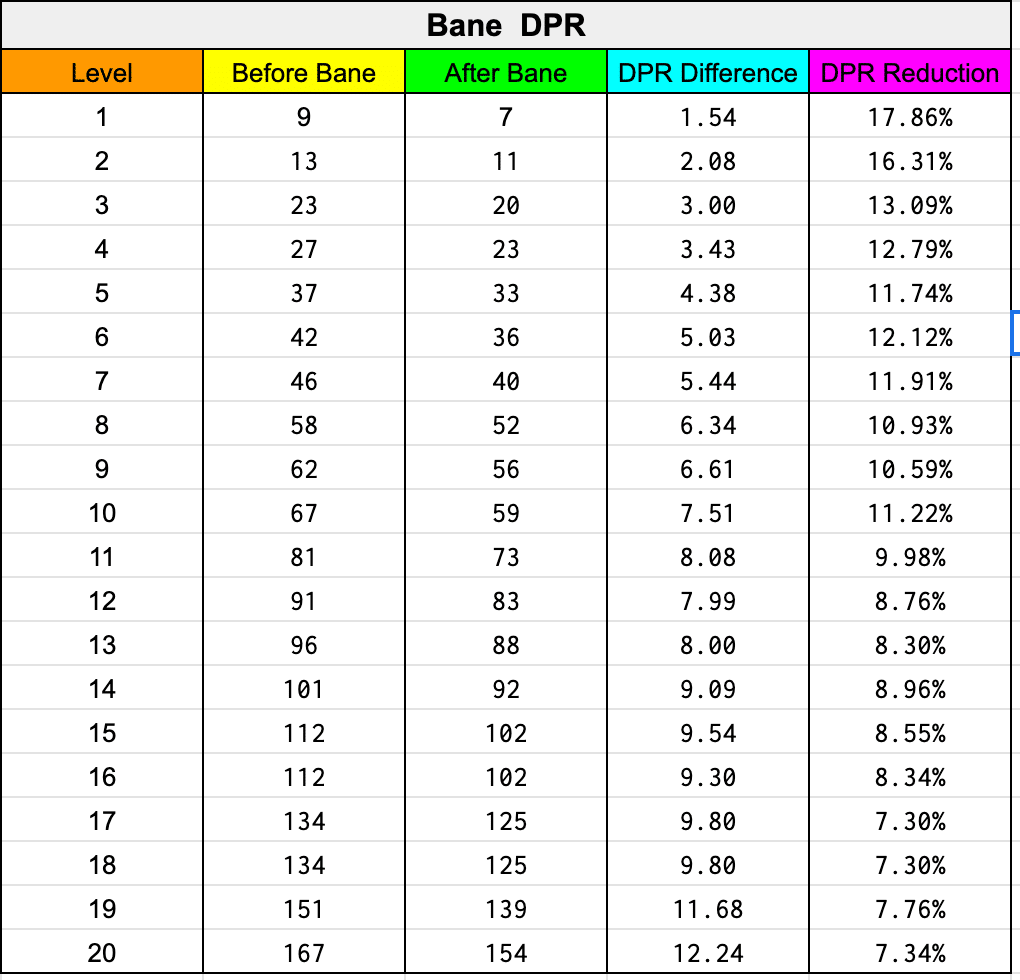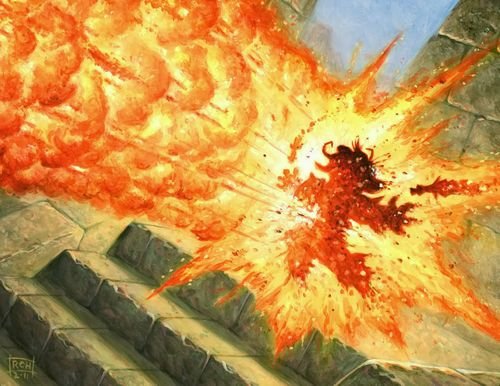Bane in 5e, a famous spell that sees very little use in comparison to its counterpart, bless. In fact, it is because I just wrote a bless article that I decided to write for bane as well.
So, then the question is how useful is bane in 5e? Bane is a spell that can be useful from levels 1-20, on average reducing a monsters DPR by 7-17%, and increasing their chances to fail a saving throw by 10-13%. In other words, great against monsters that hit, hard.
What is Bane?
Before going into the details behind Bane for 5e, we need to know what Bane is. Bane is a spell most commonly associated with the god, Bane.
Bane 5e is a 1st level concentration spell available to bards and clerics. It allows you to choose up to three creatures within 30 feet to make a Charisma saving throw. Upon failure, all attack rolls and saving throws made by the creatures must subtract a d4 from their rolls. For each level higher than It requires, you can target one additional creature on top of the original three.
If you want to read the actual verbatim, it can be found on page 216 of the Player’s Handbook.
Now let’s see the use of the spell. The spell’s primary use are against monsters with a large amount of attacks, deal significant damage, or need to fail their saving throws. As such monsters like the bullette, and Balor, but not as useful against those that cast spells like a Lich.
The conditions of needing to be within 30 feet and concentration can be either easy or challenging depending on circumstances. If you are a melee focused player, then getting them within 30 feet is not a problem, but keeping concentration is. If you are a ranged user, then it is the reverse.
Moreover, why the spell is great, there are other good spells that you forgo upon casting this spell, such as bless or shield of faith.
As such, be sure to keep these in mind when preparing this spell for the occasion. Now, let’s look at the cases this spell applies in, and how effective they actually are.
Bane 5e: Chances To Save
The biggest detriment for bane is that you can cast it and waste the spell because they rolled high. But how often does a creature pass the spell? Well, using my personal D&D calculators, at level 1, not a lot. In fact, bane has a 70.20% chance to succeed upon casting. Eventually, at level 20 a creature has a 52.79% chance to fail the saving throw. Making this a great first level spell if a boss has legendary resistance later on.
The reason being, the higher you level up, the less you use your first level spells. So, if you are trying to burn through a monsters legendary resistances, you can use a 1st level spell with a 50% chance success rate to force them either use a legendary resistance or suffer a negative d4 every attack and save. Making this a costly choice for the monster to make.
Therefore, at a worse case scenario assume a 50% success rate for this spell upon casting if you are unsure how successful it is.

Bane 5e: DPR reduction
So assuming these success rates, how much does bane actually drop a monsters DPR by. On average, a monster will deal 10.56% less damage than usual. Therefore, a monster that on average deals 60.5 points of damage in a turn, will instead deal 54 points of damage instead.
An interesting thing to note though, is that levels 1-4 have the highest dpr reduction ranging from roughly 13%-17% reduction and staying above 10% until level 11. After that, it will gradually decline to decreasing a monsters DPR by 7.34%.
This was interesting when applying the campaign theory. Which, for those that are unaware, is a theory that most campaigns end level 8 or lower. If this is the case, you can expect Bane to be effective 67.49% of the time and reduce the enemy by 13.34%.
It should be noted, this assumes an attack roll is made against you or the party. For example, A beholder forces you to make saving throws against his eye beams. So, if you were to cast bane on a beholder, the spell would do nothing against his attacks since no attack roll is made. It is however useful against a beholder if you need him to fail a save.
Bane 5e: Saving Throws
Besides reducing an enemy’s chance to hit, bane is also used to reduce enemies chances to save. But how much does a negative d4 actually affect their saves? The common assumption is 12.5% since a d4 is equivalent of 2.5 on a 20 sided die. However, when taking in monsters average saves, chance for the spell to not work, as well as the average spell DC per level. The results varied.
Surprisingly, the biggest effect bane has on saves is for CON saves. On average, an opponent who has bane cast on him will fail 14% more than an enemy who makes the save without bane cast on them.
And the trend continued, the saves that were easiest for a monster to save against suffered the biggest drawbacks. For example, Strength and Wisdom saves see a 12.56% and 11.89% chance to fail a save. However, for intelligence saving throws, the increase to fail was only 9.99%, the lowest of all of them.
This means that if you are to cast it on an enemy, your biggest noticable difference will be for saves that are easy to make, such as CON. However, do keep in mind that why the biggest differences come on hard saves, this does not necessarily mean they have the highest success rate.
For example, CON with bane has a 41.6% chance to succeed at level 20. While, Intelligence plus bane, will have a 75.28% chance to succeed at level 20. A 34% difference and should definitely be accounted for when using bane in 5e.

Bane DPR Saving throws.
Now that you can see the save chances, how does that correlate to increase in damage. Well, why I am unable to calculate just how debilitating failing a hold person spell is on average, I can calculate damage for DPR spells. To do that I used the spell fireball as a standard assumption for damage and ran the true DPR difference between the two to see the actual damage increase.
While you will see a 10-13% increase in failing saves, you will only see an increase in your spells DPR by 3-5%. Meaning at level 20, a 9th level fireball spell will on average deal an additional 2 points of damage to monsters.
Now to be fair, that is when bane for 5e is weakest. Only dealing an increase of 3.89%. If you were to cast this at level 5 you would deal an additional 4.84%. Otherwise known as 1 more point of damage.
So for saves of dealing damaging spells, the increase in damage on average is not that great only equating to 1-2 points of damage. Therefore, assuming other debuffs such as hold person will deal more damage on average, your better bet is to use those spells against monsters rather than spells like fireball.
Bane Conclusion
In conclusion, Bane can be incredibly potent at early levels for decreasing DPR and increasing a monsters chance to fail. But after around level 10, the bonuses begin dropping rapidly. Making this spells main use afterward for forcing legendary resistance uses with a 50% success rate.
If you enjoyed this article, then I feel almost obligated to mention that I wrote a bless article as well. The two spells are so closely related that they are always compared. So see the results for yourself and make your own conclusions!
- P.S. If you enjoyed this post and want to analyze your own spells, monsters, and party, download my D&D calculator! It’s a tool I use to calculate true DPR for spells and monsters in my campaigns. If you are still unsure by my little blurb then check out the review I made and see all the nifty abilities it has!

